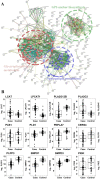Targeted UPLC-MS Metabolic Analysis of Human Faeces Reveals Novel Low-Invasive Candidate Markers for Colorectal Cancer
- PMID: 30200467
- PMCID: PMC6162413
- DOI: 10.3390/cancers10090300
Targeted UPLC-MS Metabolic Analysis of Human Faeces Reveals Novel Low-Invasive Candidate Markers for Colorectal Cancer
Abstract
Low invasive tests with high sensitivity for colorectal cancer and advanced precancerous lesions will increase adherence rates, and improve clinical outcomes. We have performed an ultra-performance liquid chromatography/time-of-flight mass spectrometry (UPLC-(TOF) MS)-based metabolomics study to identify faecal biomarkers for the detection of patients with advanced neoplasia. A cohort of 80 patients with advanced neoplasia (40 advanced adenomas and 40 colorectal cancers) and 49 healthy subjects were analysed in the study. We evaluated the faecal levels of 105 metabolites including glycerolipids, glycerophospholipids, sterol lipids and sphingolipids. We found 18 metabolites that were significantly altered in patients with advanced neoplasia compared to controls. The combinations of seven metabolites including ChoE(18:1), ChoE(18:2), ChoE(20:4), PE(16:0/18:1), SM(d18:1/23:0), SM(42:3) and TG(54:1), discriminated advanced neoplasia patients from healthy controls. These seven metabolites were employed to construct a predictive model that provides an area under the curve (AUC) median value of 0.821. The inclusion of faecal haemoglobin concentration in the metabolomics signature improved the predictive model to an AUC of 0.885. In silico gene expression analysis of tumour tissue supports our results and puts the differentially expressed metabolites into biological context, showing that glycerolipids and sphingolipids metabolism and GPI-anchor biosynthesis pathways may play a role in tumour progression.
Keywords: biomarkers; colorectal cancer; faecal samples; metabolomics.
Conflict of interest statement
The authors declare no conflict of interest. The funders had no role in the design of the study; in the collection, analyses, or interpretation of data; in the writing of the manuscript, and in the decision to publish the results.
Figures




References
-
- Zauber A.G., Winawer S.J., O’Brien M.J., Lansdrop-Vogelaar I., van Ballegooijen M., Hankey B.F., Shi W., Bond J.H., Schapiro M., Panish J.F., et al. Colonoscopic Polypectomy and Long-Term Prevention of Colorectal-Cancer Deaths. N. Engl. J. Med. 2012;366 doi: 10.1056/NEJMoa1100370. - DOI - PMC - PubMed
LinkOut - more resources
Full Text Sources
Other Literature Sources
Miscellaneous

